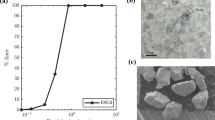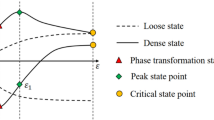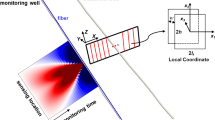Abstract
Probe permeameter has been widely used to obtain measurements and spatial distributions of permeability in both the laboratory and field outcrop applications. It provides cheap, fast, intensive, and nondestructive permeability measurements. In the literature, the difference between steady-state and unsteady-state measurements and the effects of heterogeneity and anisotropy on probe permeameter measurements have been investigated both numerically and experimentally. However, the available work provides a method for the determination of the permeability in two principal directions only. This study fills such a gap by providing a novel solution for the steady-state single-phase flow problem for the determination of permeability anisotropy in the three principal directions using probe permeameter measurements. The solution was obtained by solving the diffusivity equation describing the steady-state flow of a single-phase fluid in a three-dimensional (3D) rectangular system. Different permeability anisotropy ratios were tested for different anisotropy cases starting from a fully isotropic sample to a fully anisotropic sample. The obtained results are presented graphically in a dimensionless space. The dimensionless parameters include the dimensionless pressure and anisotropy ratios in different flow directions. A practical procedure based on the solution is then described to evaluate the permeability in a 3D rectangular rock sample. This method requires a few measurements of steady-state flow rate and pressure drop conducted using the probe permeameter at different directions on a rectangular rock sample. The applicability of the proposed solution and developed technique is demonstrated by conducting probe permeameter measurements on three different directions of one cubical cement sample and two outcrop carbonate samples. The results obtained from the proposed method show good match (an average root-mean-square error of 0.653 mD) when compared to the reference permeability values measured on directional plugs by conventional nitrogen permeameter. The procedure described in this work can be used to have a quick and robust evaluation of permeability anisotropy from rock samples in either outcrop or laboratory studies.









Similar content being viewed by others
Abbreviations
- \(A_{s}\) :
-
Cross-sectional area in s-direction, ft2
- \(B\) :
-
Formation volume factor, bbl/STB
- b :
-
Klinkenberg slip factor, psi
- C i :
-
Arbitrary constants
- cc:
-
Cubic centimeter (cm3)
- \(k_{{\text{g}}}\) :
-
Gas permeability, mD
- \(k_{{\text{L}}}\) :
-
Liquid permeability, mD
- \(k_{s}\) :
-
Permeability in s-direction, mD
- \(L\) :
-
Length of the sample, ft
- \({\text{min}}\) :
-
Minute
- \(P\) :
-
Pressure, psi
- \(P_{{{\text{atm}}}}\) :
-
Atmospheric pressure = 14.7 psi
- \(P_{{{\text{D}}_{s} }}\) :
-
Dimensionless pressure in s-direction
- \(P_{{\text{m}}}\) :
-
Mean pressure, psi
- \(P_{{\text{p}}}\) :
-
Probe pressure, psi
- \(p\) :
-
Pressure drop across the sample, psi
- \(q\) :
-
Fluid flow rate, cc/min
- \(q_{{\text{m}}}\) :
-
Fluid flow rate at \(P_{{\text{m}}}\), cc/min
- \(r_{{\text{p}}}\) :
-
Probe size, cm
- \(R_{{{\text{D}}_{Pij} }}\) :
-
Ratio of dimensionless pressure in i-direction to that in j-direction
- \(R_{ij}\) :
-
Permeability ratio between i-direction and j-direction (anisotropy ratio)
- RMSE:
-
Root-mean-square error
- \(s\) :
-
Subscript to denote the direction
- \(x\) :
-
x-Direction
- \(y\) :
-
y-Direction
- \(z\) :
-
z-Direction
- \(\beta_{{\text{c}}}\) :
-
Conversion factor to field units = \(1.127 \times 10^{ - 3}\)
- \(\mu\) :
-
Fluid viscosity, cP
References
Davis, J.M.; Wilson, J.L.; Phillips, F.M.: A portable air-minipermeameter for rapid in situ field measurements. Groundwater 32(2), 258–266 (1994). https://doi.org/10.1111/j.1745-6584.1994.tb00640.x
Sharp, J.M., Jr.; Fu, L.; Cortez, P.; Wheeler, E.: An electronic minipermeameter for use in the field and laboratory. Groundwater 32(1), 41–46 (1994). https://doi.org/10.1111/j.1745-6584.1994.tb00609.x
Dutton, S.P.; Willis, B.J.: Comparison of outcrop and subsurface sandstone permeability distribution, lower cretaceous fall river formation, South Dakota and Wyoming. J. Sedim. Res. 68(5), 890–900 (1998). https://doi.org/10.2110/jsr.68.890
Fossen, H.; Schultz, R.A.; Torabi, A.: Conditions and implications for compaction band formation in the Navajo sandstone, Utah. J. Struct. Geol. 33(10), 1477–1490 (2011). https://doi.org/10.1016/j.jsg.2011.08.001
Rogiers, B.; Beerten, K.; Smeekens, T.; Mallants, D.: Air permeability measurements on neogene and quaternary sediments from the campine area: using outcrop analogues for determining hydrodynamic aquifer properties. In: SCK CEN ER-177, p. 23 (2011)
Dykstra, H.; Parsons, R.: The Prediction of Oil by Waterflood, 2nd edn. API, New York (1959)
Eijpe, R.; Weber, K.: Mini-permeameters for consolidated rock and unconsolidated sand. Am. Assoc. Pet. Geol. Bull. 55(2), 307–309 (1974)
Goggin, D.J.; Thrasher, R.L.; Lake, L.W.: A theoretical and experimental analysis of minipermeameter response including gas slippage and high velocity flow effects. Insitu 12, 79–116 (1988)
Filomena, C.M.; Hornung, J.; Stollhofen, H.: Assessing accuracy of gas-driven permeability measurements: a comparative study of diverse Hassler-cell and probe permeameter devices. Solid Earth 5(1), 1–11 (2014). https://doi.org/10.5194/se-5-1-2014
Hurst, A.; Goggin, D.: Probe permeametry: an overview and bibliography. Am. Assoc. Pet. Geol. Bull. 79(3), 463–473 (1995). https://doi.org/10.1306/8D2B1566-171E-11D7-8645000102C1865D
Jones, S.: A new, fast, accurate pressure-decay probe permeameter. Soc. Pet. Eng. 9(03), 193–199 (1994). https://doi.org/10.2118/24757-PA
Jones, S.: A rapid accurate unsteady-state Klinkenberg permeameter. Soc. Pet. Eng. J. 12(05), 383–397 (1972). https://doi.org/10.2118/3535-PA
Dinwiddie, C.L.; Molz, F.J.; Castle, J.W.: A new small drill hole minipermeameter probe for in situ permeability measurement: fluid mechanics and geometrical factors. Water Resour. Res. (2003). https://doi.org/10.1029/2001WR001179
Al-Jabari, N.; Bowen, D.; Smart, B.; Somerville, J.: First non-contact mini-permeameter. In: International Symposium of the Society of Core Analysts (2012)
Brown, S.; Smith, M.: A transient-flow syringe air permeameter. Geophysics (2013). https://doi.org/10.1190/geo2012-0534.1
Young, G.R.: Determining Permeability Anisotropy from a Core Plug Using a Minipermeameter. University of Texas at Austin, Austin (1989)
Manrique, J.F.; Kasap, E.; Georgi, D.: Effects of heterogeneity and anisotropy on probe measured permeabilities. SPE J. 2(01), 16–23 (1997). https://doi.org/10.2118/27650-PA
Al-Azani, K.; Al-Yousef, H.; Mahmoud, M.: Effect of permeability anisotropy on probe permeameter measurements. In: SPE Middle East Oil and Gas Show and Conference. Society of Petroleum Engineers, Manama, Bahrain (2019). https://doi.org/10.2118/194769-MS
Tidwell, V.C.; Wilson, J.L.: Laboratory method for investigating permeability upscaling. Water Resour. Res. 33(7), 1607–1616 (1997). https://doi.org/10.1029/97WR00804
Tartakovsky, D.M.; Moulton, J.D.; Zlotnik, V.A.: Kinematic structure of minipermeameter flow. Water Resour. Res. 36(9), 2433–2442 (2000). https://doi.org/10.1029/2000WR900178
Ayan, C., et al.: Measuring permeability anisotropy: the latest approach. Oilf. Rev. 6(4), 24–35 (1994)
Meyer, R.: Anisotropy of Sandstone Permeability (2002)
Lewis, J.J.M.: Outcrop-derived quantitative models of permeability heterogeneity for genetically different sand bodies. In: SPE Annual Technical Conference and Exhibition. Society of Petroleum Engineers, Houston, Texas (1988). https://doi.org/10.2118/18153-MS
Clavaud, J.-B.; Maineult, A.; Zamora, M.; Rasolofosaon, P.; Schlitter, C.: Permeability anisotropy and its relations with porous medium structure. J. Geophys. Res. Solid Earth (2008). https://doi.org/10.1029/2007JB005004
Ghanizadeh, A.; Bhowmik, S.; Haeri-Ardakani, O.; Sanei, H.; Clarkson, C.R.: A comparison of shale permeability coefficients derived using multiple non-steady-state measurement techniques: examples from the Duvernay Formation, Alberta (Canada). Fuel 140, 371–387 (2015). https://doi.org/10.1016/j.fuel.2014.09.073
Mokhtari, M.; Tutuncu, A.N.: Characterization of anisotropy in the permeability of organic-rich shales. J. Pet. Sci. Eng. 133, 496–506 (2015). https://doi.org/10.1016/j.petrol.2015.05.024
Morton, K.; Thomas, S.; Corbett, P.; Davies, D.: Detailed analysis of probe permeameter and interval pressure transient test permeability measurements in a heterogeneous reservoir. Pet. Geosci. 8(3), 209–216 (2002). https://doi.org/10.1144/petgeo.8.3.209
Camargo, J.E.N.; Jensen, J.L.: Analysis of fault permeability using mapping and flow modeling, hickory sandstone aquifer, Central Texas. Nat. Resour. Res. 21(3), 395–409 (2012). https://doi.org/10.1007/s11053-012-9181-5
Hadley, D.R.; Abrams, D.B.; Roadcap, G.S.: Modeling a large-scale historic aquifer test: insight into the hydrogeology of a regional fault zone. Groundwater 58(3), 453–463 (2020). https://doi.org/10.1111/gwat.12922
Sirat, M.; Noufal, A.; Simon, J.; Zhang, X.; Subbiah, S.K.: Geomechanical heterogeneity diagnosis of carbonate reservoirs in onshore Abu Dhabi. In: Abu Dhabi International Petroleum Exhibition and Conference, p. 18 (2015). https://doi.org/10.2118/177569-MS
Ertekin, T.; Abou-Kassem, J.; King, G.: Formulation of basic equations for single-phase flow. In: Basic Applied Reservoir Simulation, vol. 7, pp. 57–74 (2001). Society of Petroleum Engineers, Richardson, Texas, US
Richardson, L.F.: The approximate arithmetical solution by finite differences of physical problems involving differential equations, with an application to the stresses in a masonry dam. Philos. Trans. R. Soc. Lond. Ser. A Contain. Pap. A Math. Phys. Charact. 210, 307–357 (1911)
Smith, G.D.: Numerical Solution of Partial Differential Equations: Finite Difference Methods, 3rd edn. Oxford University Press, Oxford (1985)
Darcy, H.: Les fontaines publiques de la ville de Dijon, Dalmont. Dalmont, Paris (1856)
Klinkenberg, L.J.: The permeability of porous media to liquids and gases. In: Drilling and Production Practice. American Petroleum Institute, New York, New York, p. 14 (1941), [Online]
Al-Yousef, H.Y.: Permeability anisotropy measurement on whole cores—analytical solution and application. In: SPE Middle East Oil and Gas Show and Conference. Society of Petroleum Engineers, Manama, Bahrain (2005). https://doi.org/10.2118/93559-MS
Author information
Authors and Affiliations
Corresponding author
Rights and permissions
About this article
Cite this article
Al-Azani, K., El-Husseiny, A., Mahmoud, M. et al. Numerical and Experimental Study to Determine the Permeability Anisotropy in Porous Rocks from Probe Permeameter Measurements. Arab J Sci Eng 46, 7019–7030 (2021). https://doi.org/10.1007/s13369-021-05433-w
Received:
Accepted:
Published:
Issue Date:
DOI: https://doi.org/10.1007/s13369-021-05433-w




